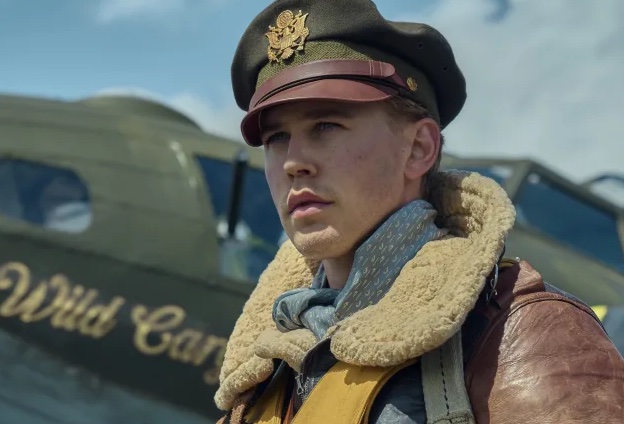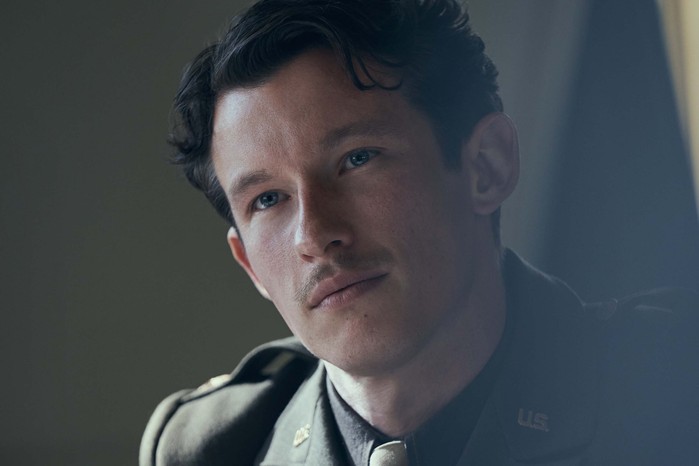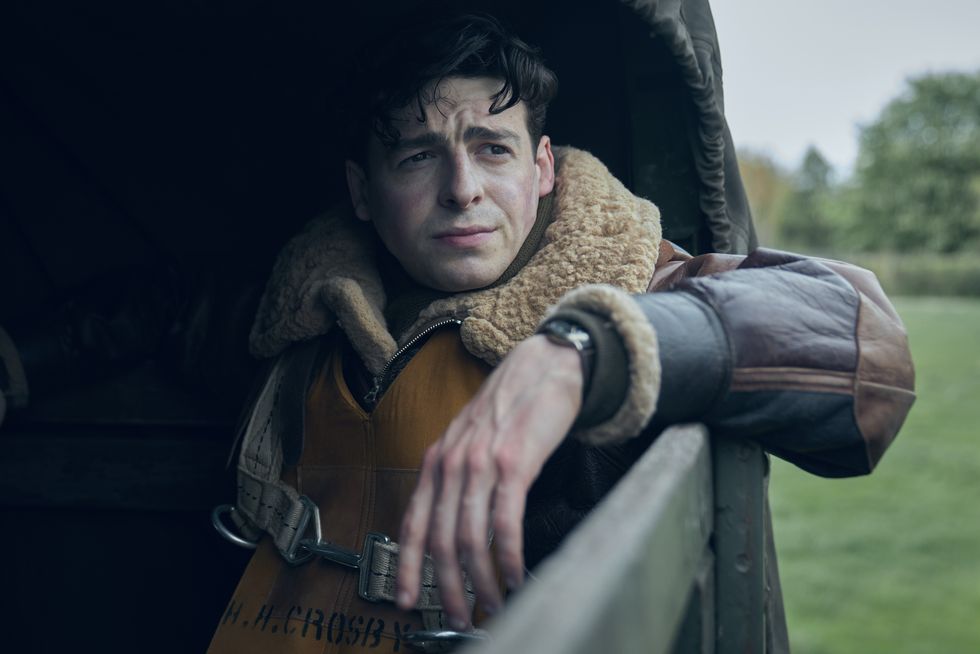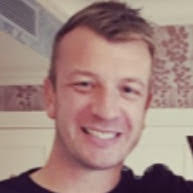Is Masters of the Air based on a true story? Meet the real heroes
Masters of the Air tells the story of the US Army Air Force’s 100th Bomb group and its part in World War Two…

Masters of the Air is based on a true story and here we look at the real people depicted in the Apple TV Plus show.
The drama tells the story of the real 100th Bomb Group, nicknamed "The Bloody Hundredth" due to the many losses they suffered during exploits in the skies above Germany.
Brought to the screen by executive producers Steven Spielberg and Tom Hanks, the nine-part series is seen as a companion to their previous TV series, Band of Brothers and The Pacific.
The new show is streaming on Apple TV Plus, and we've got a guide on how to watch Masters of the Air if you need any help in watching it yourself.
Based on Donald L. Miller’s acclaimed 2007 book of the same name, the drama follows Major Gale ‘Buck’ Clevens (Austin Butler), Major John ‘Bucky’ Egan (Callum Turner), Lt Harry 'Cros' Crosby (Anthony Boyle) and Lt Robert 'Rosie' Rosenthal (Nate Mann) as they carry out dangerous daytime bombing on Nazi military targets.
Yet who were the real men behind the legends and what happened to them after the war? Here's everything you need to know...
* Spoilers for Apple TV+ series Masters of the Air follow *
The latest updates, reviews and unmissable series to watch and more!
Who was Major Gale ‘Buck’ Cleven?

Played by Elvis star Austin Butler in the show, Gale Cleven was born on December 27, 1918, in Lemmon, rural Perkins County, South Dakota, before his family moved to Lusk, Wyoming, when he was a year old. As a young man he worked in the oil fields to pay for his education at the University of Wyoming, where he received a full academic scholarship, majoring in math.
Cleven signed on as a flight cadet at the Randolph Air Force Base in Texas in March 1940, where he met John ‘Bucky’ Egan, who gave him the nickname ‘Buck’, as he reminded him of a man he knew back home in Wisconsin — as shown in Masters of the Air.
Cleven quickly progressed through the ranks and joined the Army Air Force as a pilot in 1941, before being put in charge of the 350th Bomb Squadron, who were sent to RAF Thorpe Abbotts, a Royal Air Force station located in Norfolk, England, in May 1943. While there they where they were joined by the 100th and 418th Bomb Group.
Cleven's first mission was to Bremen on 25th June 1943 and his 11th was the much-documented raid on Regensburg of August 17, 1943, which features in the third episode of the Apple TV Plus series.
Cleven was in the right-hand seat of the lead plane in the low squadron for the mission (the Group flying 'tail-end Charlie') and his unit was hit by fierce enemy fire as soon as crossed the channel. His plane took a number of hits before reaching the target, which resulted in the death of one crew member, serious injury to another and damaged hydraulics and electrical systems.
When another 20mm shell ripped the nose of the plane, wounded the crew's bombardier and took hits to Engine no.3 the pilot signaled a bale-out, but Cleven countermanded the order, took over the controls, eventually landing the plane in Africa.
However, on another mission on 8 October 1943 he was forced to crash land after his left wing was destroyed. In his memoirs, he describes landing in front of a farmhouse, with a pitchfork being pointed at his chest after he landed.
As a POW he was interrogated by the German military, before eventually being moved to the Stalag Luft III Sagan camp the morning of October 23, 1943. Life in the camp was hard and as the Russian forces invaded from the East in the months to come, conditions became tougher, with rations getting smaller and punishments getting more brutal.
On the evening of January 27, 1945, Cleven and some other POWs heard a call to evacuate the camp on illegal radios they'd been using. It was an event the prisoners had been planning for and they escaped the camp, going on the run through Germany for 12 days and eventually making it back to Thorpe Abbotts — an event loosely alluded to in Masters of the Air.
Cleven married the girlfriend he'd left behind, Marge Spencer, within months of returning from the war, with Major John Egan as his best man. He continued to serve his country in the Korean War as well as in Vietnam as part of the Air Force, even working at the Pentagon for a short time, before officially retiring as a full Colonel in 1955. He then earned both an M.B.A. from Harvard and Ph.D from Georgetown University, before becoming the manager of Webber College in Florida, turning it into a successful business school.
He passed away on November 17, 2006, at the age of 87.
Who was the real John 'Bucky' Egan?

Major John Egan — who's played by Callum Turner in the series — was born in Manitowoc, Wisconsin, on 9th September 1915. He arrived at Randolph Field as a flying cadet, where he met his lifelong friend Gale Cleven in March 1940. His nickname of “Bucky” was apparently acquired at this time, because he reminded a colleague of someone known as Bucky, which might explain why he carried on that tradition with Buck!
By August 1942 he'd risen through the ranks to become a Captain and was made Army Air Field as Operations Officer for the 100th Bomb Group, before flying to Britain with the advance party in May 1943. In June took over command of the 418th Bomber Squadron at Thorpe Abbotts.
In his trademark sheepskin jacket — which Masters of the Air fans will recognise — Egan flew on some dozen combat missions with the 100th, usually in the co-pilot's seat (the left-hand seat). In his memoir “A Wing and a Prayer” Major Harry Crosby describes Egan and Cleven as... "Air Corps raunch, their hats cocked on the back of their heads, both wearing white scarves, the souls of romanticism, hated discipline."
Others remembered how he could “turn on the charm and turn it off whenever he liked” and he spent plenty of time at the local pub in Dickleburgh, where he sang songs in the bar with the locals.
Egan was present on the ill-famed Regensburg raid of 17 August 1943, when nine B-17's in the Group were shot down. “We were under fighter attack for three and a half hours,” he explained later. “I saw three Fortresses immediately around us shot down between the German border and the target. No one turned back, although some of us thought we were as good as dead”.
A post shared by 100th Bomb Group Foundation (@100thbgf)
A photo posted by on
Yet October was a terrible month for the 8th Air Force and Egan was one of many airmen shot down during the Münster raid of October 10. He was Command Pilot (sitting in the right-hand seat) on John Brady's lead crew in “M’lle Zigzag” when they were attacked by countless enemy fighters, which harried them for nearly an hour. Lt Robert Rosenthal’s “Royal Flush” was the only plane that got back to base.
Two days earlier Cleven had gone down on a raid over Bremen and in his memoirs, Lt Harry Crosby explains how Egan had demanded to lead the next mission to avenge his buddy, as seen in Masters of the Air.
After being shot down on the next mission, Egan was taken to Stalag Luft III, where he was reunited with his old friend. It’s believed the first thing Cleven said when he saw Egan was “What the Hell took you so Long” with Egan replying, “That's what I get for being sentimental”!
Egan managed to escape Stalag Luft III in October 1943, but was re-captured. He was then the instigator for the long-term planning of tunnels named Tom, Dick and Harry, which were eventually to be used in the “great escape” (which inspired the iconic movie of the same name) in March 1944. Three men got away, but of the 76 captured as they emerged from the tunnel, 50 were shot on Hitler's personal orders.
Egan's involvement in that plot is not covered in Masters of the Air, but we suppose it's another story all together!
Following news of the Russian advances broadcast on the German news, on the evening of 27 January 1945, the POWs were evacuated, with an estimated 10,000 men marching out of Sagan in a column fifteen miles long.
The march was made in horrendous conditions, as temperatures dipped well below freezing and all roads west became jammed up with fleeing German civilians. Frostbite and dysentery were rampant, yet Egan survived to make it back to the US.
After the war he returned to Manitowoc and bumped into an old high school acquaintance, Josephine Pitz, who was still in uniform as a WASP (Women’s Air Service Pilot). They were married a few months later.
Egan later served in Korea and following duties in the Far East, he eventually became Director of Air Force Operations for the entire Pacific Theatre, before attending the National War College in Washington DC.
In 1961 he was working at the Pentagon when he died of a heart attack at the age of 45. He was buried in Arlington National Cemetery with full military honours.
Who was the real Harry Crosby?

Played by Anthony Boyle, Major Harry Crosby was born on 18 April 1919 in the city of New England, North Dakota. He attended the University of Iowa but suspended his studies in December 1941 to enlist in the United States Air Force following the Japanese attack on Pearl Harbour.
He was assigned to Mather Air Force Base, where he trained as a B-17 Flying Fortress navigator, before being transferred to Boise, Idaho, where he was assigned to the 418th Squadron of the 100th Bomb Group. In May 1943 he was one of 36 original "Bloody 100th" combat crews who flew their B-17s to Thorpe Abbotts RAF base in Norfolk, as depicted in Masters of the Air.
His first combat mission was June 28, 1943, and on 29th July 1943, he was a lead navigator for his first mission, 1,900 mile trip to Trondheim, Norway.
He also took part in the Regensburg to Africa shuttle raid and the 100th's long shuttle to Migorod via Ruhland, which was a particularly dangerous target that lay just south of Berlin. This second shuttle mission was code-named "Frantic" and required the utmost in precision, as the distance was at the limit of the maximum range of the B-17.
In November 1943 he was promoted to lead navigator of the 100th Bomb Group and would go on to lead missions of as many as 2000 heavy bombers. By the end of the war he'd flown 32 combat missions.
The early episodes of Masters of the Air depict Major Crosby as suffering from air sickness, which was true. Many navigators suffered from this affliction, as they frequently had to look at the ground through drift sights and make calculations while flying — yet Crosby said he suffered more than most.
In his memoirs "A Wing and a Prayer" Crosby also reveals how on 12 August 12, 1943, he made a strange decision not to bomb Bonn due to a record he’d listened to the night before…
“It just happened that the night before, after I had been given a pre-briefing, I had returned to my quarters and was playing some records on what in England was called a gramophone . . . I had the complete Third Symphony (Eroica) and the complete Fifth Symphony. As I played the records I rather idly read the inscription on the inside cover of the album. I noticed without paying much attention that Beethoven had been born in and had gone to school in Bonn.
“On the next day, 25,000 feet in the air, when we started our run on Bonn, I looked down and saw a series of buildings which I presumed to be the University of Bonn. Instantly there flashed through my mind the thought, ‘That must be where Beethoven went to school!’
“I grabbed our bombardier Douglass by the shoulder and said we would not go to Bonn. Over the intercom someone asked me why not and, after giving the pilot a new heading, I explained that this was where Beethoven went to school.
“In those tense moments for some reason nobody objected and we made a run on a marshalling yard in Cologne which was listed as a target of opportunity. We were the lead ship in the whole Eighth Air Force that day and therefore the entire formation followed us..”
After the war Crosby returned to college and graduated from Iowa in 1947 and earned a Ph.d from Stanford in 1953, before teaching English composition and American literature at the University of Iowa.
In 1958 he moved with his wife and four children to Newton, Massachusetts for a faculty position at the College of Basic Studies at Boston University, retiring in 1984.
Harry Crosby died on July 28, 2010, at age 91.
Who was the real Robert Rosenthal?

Portrayed by Nate Mann in the series, Rosenthal was born on 11 June 1917 in Brooklyn. When the Japanese attacked Pearl Harbour in December 1941, he was a law graduate working at a law firm in Manhattan. He enlisted for service the next day and in August 1943 joined the 418th Squadron of the 100th Bomb Group, stationed at Thorpe Abbotts, as a pilot and aircraft commander of a B-17 Flying Fortress crew.
Rosenthal's third mission was a raid over Münster on 10 October 1943, from which his plane was the only one to return. It had two dead engines, the intercom and the oxygen system was non-functional, and a severely damaged right wing — an event shown in Masters of the Air. Whether he hummed a jazz tune while doing it is unclear.
In September 1944, his plane was shot down over German-occupied France. He broke his right arm and nose upon landing and was rescued by the Free French, before returning to duty — an event not included in the Apple TV Plus series!
By March 1944, Rosenthal's crew, nicknamed "Rosie's Riveters", with their Fort bearing the same name, completed their 25 mission combat tour and returned to the United States, but Rosenthal extended his tour, eventually flying a total of 52 missions.
His penultimate mission, a dangerous raid on Berlin, took place on February 3, 1945. Despite his bomber suffering a direct hit and bursting into flames, he continued to the target, dropped his bombs and stayed with the plane until after the rest of the crew had bailed out, just before it exploded. He was recovered by the Red Army and again returned to duty — as shown in Masters of the Air.
After the war, he served as an assistant to the U.S. prosecutor at the Nuremberg Trials, where he interrogated Hermann Göring.
In July 1946, while heading to Germany by ship, he met a Navy lawyer, Phillis Heller, who was also joining the American legal team in Nuremberg. Ten days later, they were engaged, and married on 14th Sept 1946.
Robert Rosenthal died on April 20, 2007, at age 89.
Sean is a Senior Feature writer for TV Times, What's On TV and TV & Satellite Week, who also writes for whattowatch.com. He's been covering the world of TV for over 15 years and in that time he's been lucky enough to interview stars like Ian McKellen, Tom Hardy and Kate Winslet. His favourite shows are I'm Alan Partridge, The Wire, Wolf Hall and Succession and in his spare time he enjoys drinking tea, doing crosswords and watching football.


